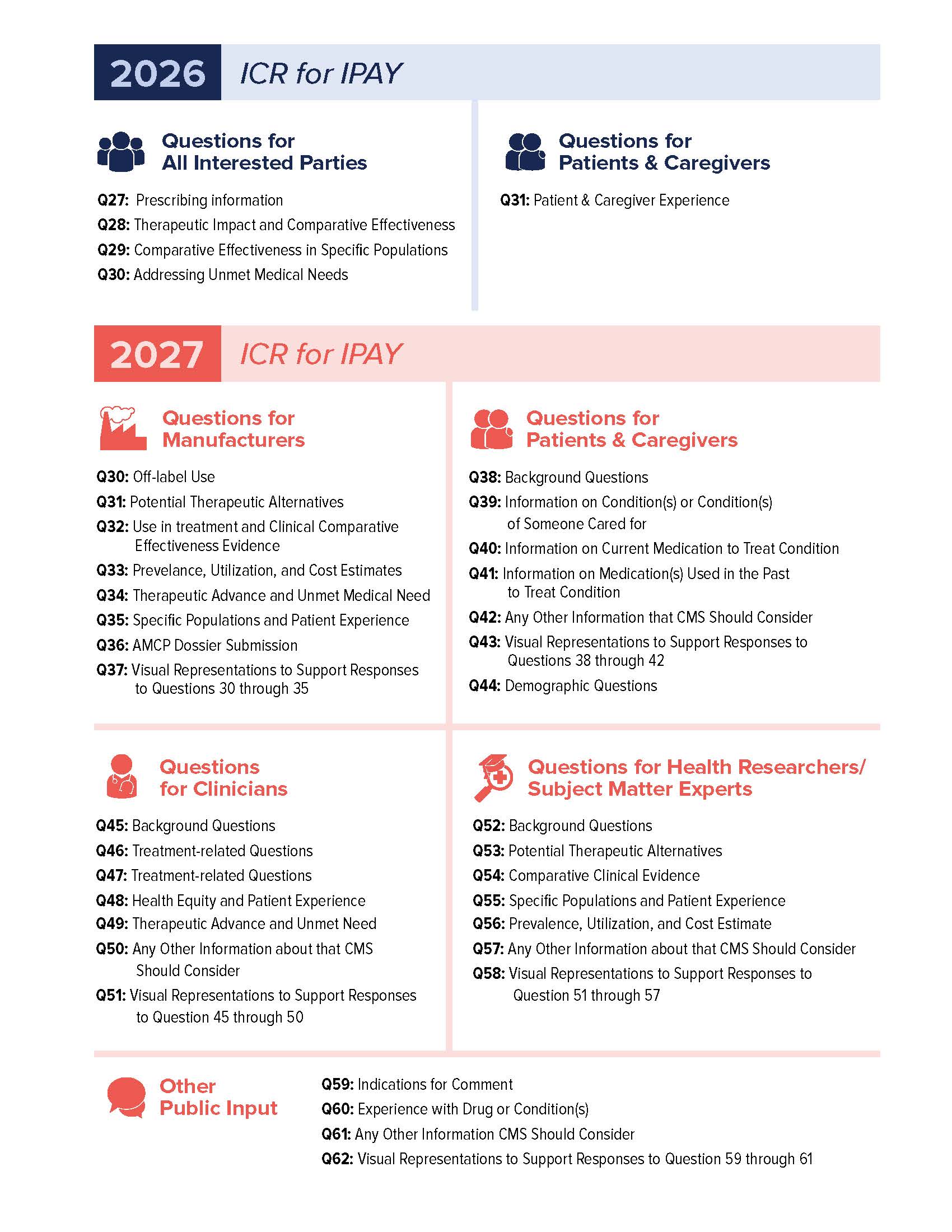
Insights on Centers for Medicare and Medicaid Services (CMS) Updates for IPAY 2027
The names of the drugs selected for the second cycle of Medicare drug price negotiations (DPNs) will be released soon. At this point, it is imperative that manufacturers consider what information and evidence they can submit in support of their products, should they be chosen. In a previous post, we explored DPN program guidance on drug selection, the negotiation process, and the information Centers for Medicare and Medicaid Services (CMS) will consider for the initial price applicability year (IPAY) of 2027. In this article, we take a deeper dive into the Information Collection Request (ICR) form, which manufacturers use to submit data to CMS in support of their products.
Introducing the Information Collection Request (ICR)
According to Section 50 of the DPN guidance, manufacturers must submit certain types of information as part of the negotiation process. They may also include evidence supporting their product compared with therapeutic alternatives. These data elements were revised in a new ICR form for IPAY 2027 published on 2 July 2024. The form includes information on drug pricing, costs of development, status of relevant patents, and sales volume data.
The optional elements of the ICR form are discussed in Section I, “Evidence on Alternative Treatments.” In the analysis below we explore how the optional elements in Section I have changed in the second negotiation cycle (IPAY 2027). See Table 1 at the end of this article for a quick reference guide to the differences.
The #1 Key Takeaway
For manufacturers who anticipate their products may be selected for future DPN cycles, now is the time to start planning.
Manufacturers whose products have been selected must assess whether they have capacity in-house to identify and synthesize key evidence needed for the ICR form or should instead find a partner to help prepare and guide them through the process. Experts in dossier and communication materials development at RTI Health Solutions are well versed in this process.
Because an Academy of Managed Care Pharmacy (AMCP) dossier can be used as a supplemental ICR evidence source, it is advantageous for manufacturers to plan the content of their AMCP dossiers during this process to ensure that ICR-relevant information is captured.
ICR Section I Structure
One of the key ICR differences between IPAY 2026 and 2027 is the existence of multiple question blocks directed at certain respondent types in IPAY 2027 (see figure). IPAY 2026 featured a main question block for all respondents to answer. There was also a question block exclusively for patients and caregivers. The ICR for IPAY 2027 contains 5 question blocks, one for each of the following:
However, any “interested party” can answer any question in Section I. Interested parties include manufacturers, consumers, plan sponsors, hospitals, pharmacies, researchers, SMEs, patients, caregivers, and clinicians. As a reminder, Section I of the ICR for IPAY 2026 and 2027 is optional. Although manufacturers are required to submit information in Sections A-H, in some situations they may delegate the completion of Section I to SMEs or supplement their submission with responses from SMEs.
Questions for Manufacturers and Researchers
The key opportunity for manufacturers in both ICRs is to submit evidence in support of the comparative effectiveness and therapeutic advantage for the selected drug in its indication(s). Sources can include head-to-head randomized controlled trials, pragmatic clinical trials, network meta-analyses, observational studies, and real-world evidence. Both ICRs request descriptions of the extent to which the selected drug represents a therapeutic advance over alternatives and addresses an unmet medical need. Important additions to the ICR for IPAY 2027 are a request to include information on comparative effectiveness and therapeutic alternatives.
The ICRs for both IPAY 2026 and 2027 request information on health equity considerations and access challenges for patients. However, the ICR for IPAY 2027 also requests considerations related to social drivers of health and health disparities. Additionally, the 2027 manufacturer block includes a request for patient experience information, such as evidence regarding patient priorities and preferences, treatment burden, and burden of disease.
Another important addition to the ICR for IPAY 2027 is the request for prevalence, utilization, and cost information. Estimates of utilization include the total number of patients treated and the share of selected drug prescriptions for an indication. Cost information includes healthcare resource utilization associated with patients who take the selected drug compared with patients who take its potential therapeutic alternatives. Evidence may include disease burden or cost-of-illness analyses, and cost-effectiveness or cost-utility analyses.
According to the ICR for IPAY 2027, manufacturers are now permitted to submit a dossier to supplement their responses to ICR questions. This would serve as a supplement rather than a replacement for detailed responses. Dossiers should be formatted using an industry standard such as the AMCP Format for Formulary Submissions, version 5.0. The CMS advises that manufacturers submitting a dossier submit an outline of the location of information within the dossier related to ICR questions for manufacturers, to the extent applicable. If manufacturers wish to use a dossier as a supplemental source, is important that they and/or their partners plan the content of the AMCP dossier to ensure that the relevant information is included.
Questions for Patients and Caregivers
The questions for patient and caregivers in ICRs for IPAY 2027 and 2026 show a high degree of overlap, but there are several important differences. The ICR for IPAY 2027 includes several new questions regarding the indication, independent of treatment. Examples of these questions include, “How does the condition impact daily life? How has the condition progressed over time? What is important in managing the condition?”
Other questions in ICRs for IPAY 2027 and 2026 are similar; they request information on experiences with benefits, side effects, impact on daily life, and challenges with taking or accessing treatment. However, there is a significant difference in how these questions are structured. In the ICR for IPAY 2027, patients taking the medication are identified separately from those who have taken it in the past. There are additional questions regarding decisions on why patients started or stopped treatment.
Questions for Clinicians and the Public
Arguably, the largest and most unique addition to the ICR for IPAY 2027 is the set of questions for collecting clinician input. Oddly, the two main questions, Q46 and Q47, have the same name: “Treatment-Related Questions.” The intent of Q46 is to collect clinicians’ experience in using the selected drug and understand how they assess outcomes, while the intent of Q47 is to collect clinician perspectives on how the selected drug fits into the overall treatment paradigm for patients. There are also subquestions requesting clinician input on health equity and patient experience and evidence supporting the therapeutic advantage of the selected drug and its ability to address unmet needs.
The last block of questions in the ICR for IPAY 2027 requests information from the public. In this section, question-phrasing is nontechnical and open-ended, to allow anyone to contribute. Requested information includes experience with the selected drug or the condition it treats and any other information of which CMS should be aware.
Comparing Question Blocks for Respondent Types in Section I: IPAY 2026 vs 2027
Table 1: Selected Additions and Deletions in Section I of the ICR for IPAY 2027
Updates to Section I Structure (Addition) |
|
Updates to Section I Questions for Manufacturers (Additions) |
|
|
|
|
|
|
|
Updates to Section I Questions for Manufacturers (Deletions) |
|
Updates to Section I Question for Patients and Caregivers (Additions) |
|
|
|
Unique Question Types for Researchers and Clinicians Not Seen in ICR for IPAY 2026 |
|
|
|
AMCP = Academy of Managed Care Pharmacy; CMS = Centers for Medicare and Medicaid Services; ICR = information collection request; IPAY = initial price applicability year; SME = subject matter expert.
Sources: ICR for IPAY 2026; ICR for IPAY 2027.
